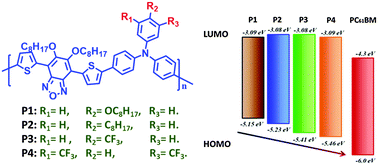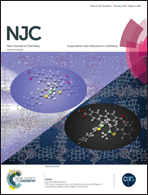Feasible energy level tuning in polymer solar cells based on broad band-gap polytriphenylamine derivatives
Abstract
A series of versatile broad band-gap alternating copolymers (P1, P2, P3 and P4) based on triphenylamine (TPA) and benzofurazan derivatives, differing in the substituted groups [–OC8H17, –C8H17, –CF3, –(CF3)2] in their triphenylamine units, were designed and synthesized by Suzuki polycondensation. The relationships between the substituted groups in TPA and the highest occupied molecular orbital (HOMO) energy levels, as well as the open circuit voltages (Vocs), were investigated in detail. The HOMO levels of these four polymers decreased sequentially when the substituted groups shifted from electron-donating groups [–OC8H17, –C8H17] to electron-withdrawing groups [–CF3, –(CF3)2], which led to the successive increase in Vocs of the polymer solar cells (PSCs) based on these polymers. Through the characterization of photovoltaic performance, the highest Voc, which reached up to 1.00 V, was achieved by the polymer with bis(trifluoromenthyl) substituted group (P4), which is one of the highest Voc values based on polytriphenylamine derived polymers for PSCs. Among these polymers, the one with octyl side chain (P2) showed the best photovoltaic performance with the highest short circuit current density (Jsc) and fill factor (FF), giving a Jsc of 4.84 mA cm−2, FF of 50%, Voc of 0.80 V and power conversion efficiency (PCE) of 2.22%.


 Please wait while we load your content...
Please wait while we load your content...